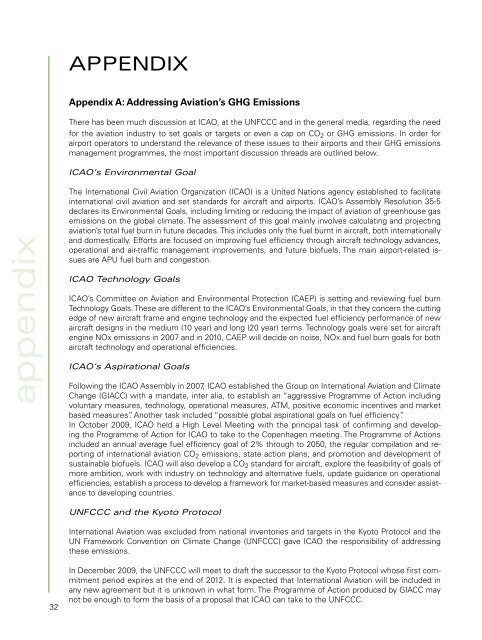Airport Greenhouse Gas Emissions Management - Zurich Airport
Airport Greenhouse Gas Emissions Management - Zurich Airport
Airport Greenhouse Gas Emissions Management - Zurich Airport
Create successful ePaper yourself
Turn your PDF publications into a flip-book with our unique Google optimized e-Paper software.
APPENDIX<br />
Appendix A: Addressing Aviation’s GHG <strong>Emissions</strong><br />
There has been much discussion at ICAO, at the UNFCCC and in the general media, regarding the need<br />
for the aviation industry to set goals or targets or even a cap on CO 2 or GHG emissions. In order for<br />
airport operators to understand the relevance of these issues to their airports and their GHG emissions<br />
management programmes, the most important discussion threads are outlined below.<br />
ICAO’s Environmental Goal<br />
appendix<br />
The International Civil Aviation Organization (ICAO) is a United Nations agency established to facilitate<br />
international civil aviation and set standards for aircraft and airports. ICAO’s Assembly Resolution 35-5<br />
declares its Environmental Goals, including limiting or reducing the impact of aviation of greenhouse gas<br />
emissions on the global climate. The assessment of this goal mainly involves calculating and projecting<br />
aviation’s total fuel burn in future decades. This includes only the fuel burnt in aircraft, both internationally<br />
and domestically. Efforts are focused on improving fuel efficiency through aircraft technology advances,<br />
operational and air-traffic management improvements, and future biofuels. The main airport-related issues<br />
are APU fuel burn and congestion.<br />
ICAO Technology Goals<br />
ICAO’s Committee on Aviation and Environmental Protection (CAEP) is setting and reviewing fuel burn<br />
Technology Goals. These are different to the ICAO’s Environmental Goals, in that they concern the cutting<br />
edge of new aircraft frame and engine technology and the expected fuel efficiency performance of new<br />
aircraft designs in the medium (10 year) and long (20 year) terms. Technology goals were set for aircraft<br />
engine NOx emissions in 2007 and in 2010, CAEP will decide on noise, NOx and fuel burn goals for both<br />
aircraft technology and operational efficiencies.<br />
ICAO’s Aspirational Goals<br />
Following the ICAO Assembly in 2007, ICAO established the Group on International Aviation and Climate<br />
Change (GIACC) with a mandate, inter alia, to establish an “aggressive Programme of Action including<br />
voluntary measures, technology, operational measures, ATM, positive economic incentives and market<br />
based measures”. Another task included “possible global aspirational goals on fuel efficiency”.<br />
In October 2009, ICAO held a High Level Meeting with the principal task of confirming and developing<br />
the Programme of Action for ICAO to take to the Copenhagen meeting. The Programme of Actions<br />
included an annual average fuel efficiency goal of 2% through to 2050, the regular compilation and reporting<br />
of international aviation CO 2 emissions, state action plans, and promotion and development of<br />
sustainable biofuels. ICAO will also develop a CO 2 standard for aircraft, explore the feasibility of goals of<br />
more ambition, work with industry on technology and alternative fuels, update guidance on operational<br />
efficiencies, establish a process to develop a framework for market-based measures and consider assistance<br />
to developing countries.<br />
UNFCCC and the Kyoto Protocol<br />
International Aviation was excluded from national inventories and targets in the Kyoto Protocol and the<br />
UN Framework Convention on Climate Change (UNFCCC) gave ICAO the responsibility of addressing<br />
these emissions.<br />
32<br />
In December 2009, the UNFCCC will meet to draft the successor to the Kyoto Protocol whose first commitment<br />
period expires at the end of 2012. It is expected that International Aviation will be included in<br />
any new agreement but it is unknown in what form. The Programme of Action produced by GIACC may<br />
not be enough to form the basis of a proposal that ICAO can take to the UNFCCC.

















